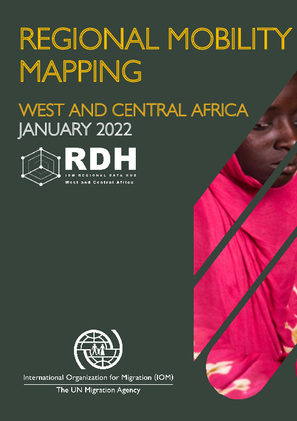-
Countries
-
Data and Analysis
-
Special Focus
-
Crisis Responses
Return migration
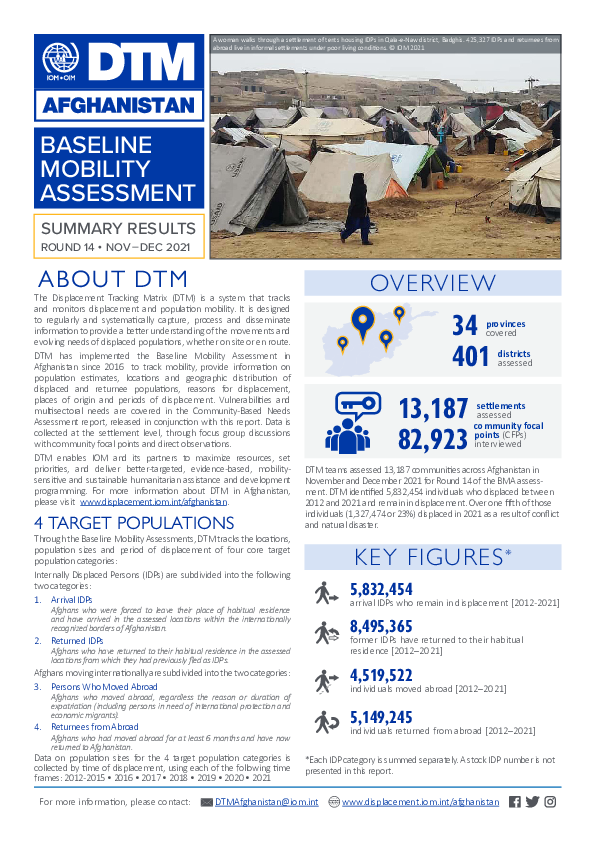
Contact
DTMAfghanistan@iom.int
Language
English
Location
Afghanistan
Period Covered
Nov 01 2021
Dec 31 2021
Activity
- Mobility Tracking
- Baseline Assessment
In Afghanistan, DTM employs the Baseline Mobility Assessment tool, designed to track mobility, determine the population sizes, locations and geographic distribution of forcibly displaced, return and migrant populations, reasons for displacement, places of origin, and times of displacement, as well as basic demographics, vulnerabilities and priority needs. Data is collected at the settlement level, through community focus group discussions with key informants and direct observations.
As of 31 December 2021, 34 provinces, 401 districts and 13,187 settlements have been assessed, including interviews with 82,923 community focal points. Between 2012 and December 2021, 5,149,245 returned migrants from abroad and 5,832,454 arrival IDPs currently living in host communities were identified.
The West and Central Africa Mobility Mapping report is a compilation of maps showing various mobility trends and mobility factors for movements to and from the West and central Africa region (forced displacement, transhumance, labour movements, etc.) This work is based on multiple data collection activities implemented by IOM and other actors (UNDESA, Ministries of Interior of various countries) and showcase the complexity of mobility in the region.
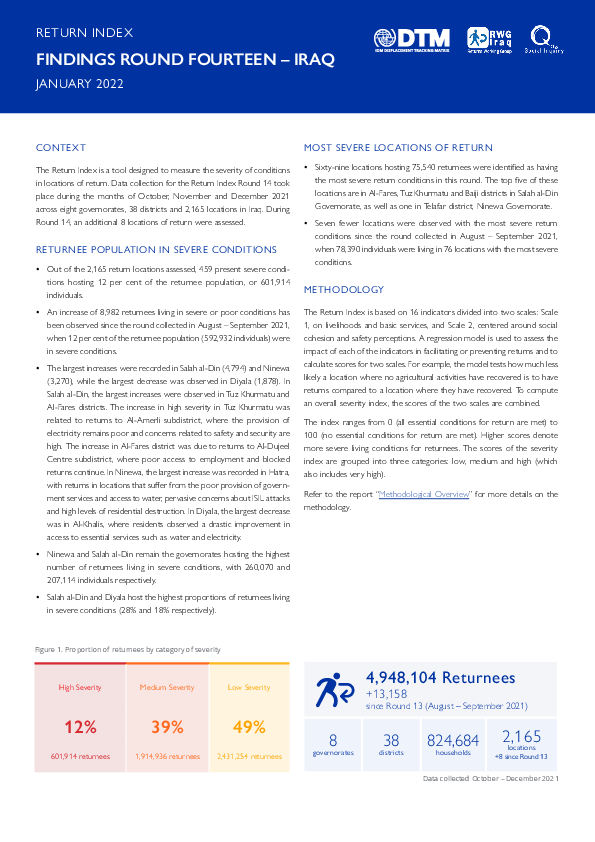
Contact
DTM Iraq, IraqDTM@iom.int
Language
English
Location
Iraq
Period Covered
Oct 01 2021
Dec 31 2021
Activity
- Survey
- Return Intention
- Mobility Tracking
- Baseline Assessment
The Return Index is a tool designed to measure the severity of conditions in locations of return. Data collection for the Return Index Round 14 took place during the months of October, November and December 2021 across eight governorates, 38 districts and 2,165 locations in Iraq. During Round 14, an additional 8 locations of return were assessed.
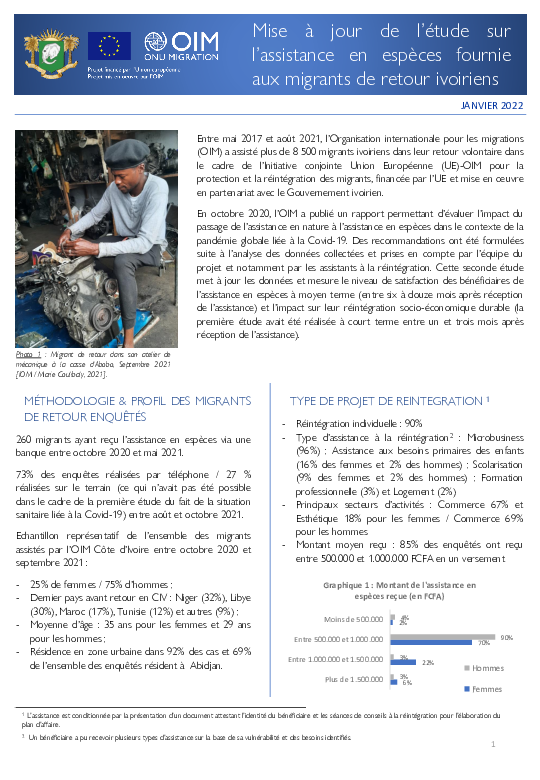
Contact
Aude Nanquette, Ananquette@iom.int
Language
French
Location
Côte d’Ivoire
Period Covered
Oct 01 2020
May 31 2021
Activity
- Other
- Survey
Cette étude met à jour les données concernant le niveau de satisfaction de 260 migrants ivoiriens de retour ayant bénéficié d'assistance en espèces et l'impact sur leur réintégration socioéconomique durable. Les données ont été recueillies entre octobre 2020 et mai 2021 au travers d'enquêtes téléphonique et sur le terrain.

Contact
DTM Nigeria, AllUsersInDTMNigeria@iom.int
Language
English
Location
Nigeria
Period Covered
Aug 30 2021
Oct 15 2021
Activity
- Mobility Tracking
- Baseline Assessment
In response to the need for accurate and up-to-date information on human mobility and forced displacement in north-east Nigeria, IOM activated its Displacement Tracking Matrix (DTM) to support the Government and the humanitarian community with
multi-layered data on the numbers, trends, status, locations and needs of populations affected by the on-going conflict in north-east Nigeria. Round 39 of assessment was conducted from 30 August to 15 October 2021.
This dashboard provides key figures on the numbers, demographic profile, location and accommodation arrangement of returnees. A total of 1,943,445 returnees were recorded in the DTM Round 39 assessment. including 1,786,667 Former IDP Returnees and 156,778 Returnees from abroad. This represents an increase of 25,382 individuals or 1 per cent compared to Round 38.

Contact
DTMAfghanistan@iom.int
Language
English
Location
Afghanistan
Period Covered
Apr 01 2021
Jun 30 2021
Activity
- Site Assessment
- Mobility Tracking
In April through June 2021, DTM implemented the Community-Based Needs Assessment (CBNA) at the settlement level, as an integral component of DTM's Baseline Mobility Assessment (BMA), providing a comprehensive overview of the evolving, multi-sectoral needs in settlements hosting IDPs and returnees.
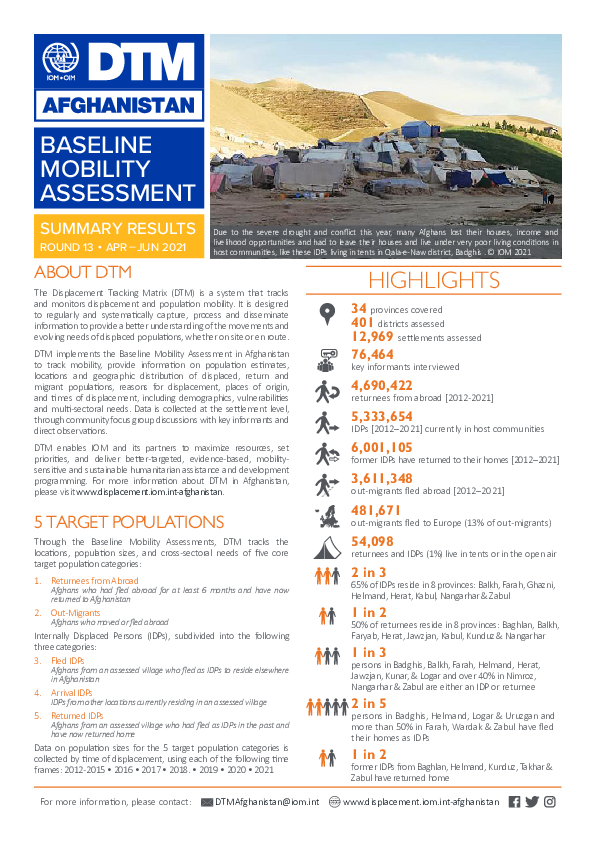
Contact
DTMAfghanistan@iom.int
Language
English
Location
Afghanistan
Period Covered
Apr 01 2021
Jun 30 2021
Activity
- Mobility Tracking
- Baseline Assessment
In Afghanistan, DTM employs the Baseline Mobility Assessment tool, designed to track mobility, determine the population sizes, locations and geographic distribution of forcibly displaced, return and migrant populations, reasons for displacement, places of origin, and times of displacement, as well as basic demographics, vulnerabilities and priority needs. Data is collected at the settlement level, through community focus group discussions with key informants and direct observations.
As of 30 June 2021, 34 provinces, 401 districts and 12,969 settlements have been assessed, including interviews with 76,464 key informants. Between 2012 and June 2021, 4,690,422 returnees and 5,333,654 IDPs currently living in host communities were identified.

Contact
DTM Djibouti, DTMDjibouti@iom.int
Language
English
Location
Djibouti
Period Covered
Nov 01 2021
Nov 30 2021
Activity
- Survey
- Flow Monitoring Survey
- Flow Monitoring
- Migrants presence
This dashboard presents the main migration trends observed in Djibouti in November 2021. It aims to provide an overview of the main mobility trends in Djibouti, through both quantitative and qualitative analyses, obtained from several data collection tools developed by IOM Djibouti.
This dashboard includes:
- A monthly update on the key data obtained through the Flow Monitoring Registry (FMR) at the 10 active Flow Monitoring Points (FMPs) in Djibouti;
- Key data on spontaneous returns from Yemen and movements observed between Djibouti and Ethiopia;
- Anmonthly update on the profile, vulnerabilities, migratory experience and intentions of the migrants surveyed through the Flow Monitoring Surveys (FMS);
- An update on the presence of migrants stranded in Djibouti.

Contact
DTM Djibouti, DTMDjibouti@iom.int
Language
French
Location
Djibouti
Period Covered
Nov 01 2021
Nov 30 2021
Activity
- Survey
- Flow Monitoring Survey
- Flow Monitoring
- Migrants presence
Ce tableau de bord présente les principales tendances migratoires observées à Djibouti en novembre 2021. Il vise à fournir une vue d'ensemble des principales dynamiques migratoires au niveau de Djibouti, en présentant des analyses à la fois quantitatives et qualitatives obtenues à travers plusieurs outils de collectes de données développées par l'OIM Djibouti.
Ce tableau de bord comprend:
- Une mise à jour mensuelle des principales données obtenues à travers l’enregistrement des flux aux 10 points de suivi des flux (FMP) actifs à Djibouti;
- Des données clés sur les retours spontanés du Yémen ainsi que sur les mouvements entre Djibouti et l'Éthiopie;
- Une mise à jour mensuelle sur les profils, vulnérabilités, parcours migratoires et intentions des personnes interrogées à travers les enquêtes individuelles (FMS);
- Une mise à jour sur la présence des migrants bloqués à Djibouti.

Contact
DTM South Sudan, SouthSudanDTM@iom.int
Language
English
Location
South Sudan
Period Covered
Sep 01 2021
Sep 30 2021
Activity
- Flow Monitoring
DTM’s Flow Monitoring Registry (FMR) surveys people on the move at key transit points within South Sudan (SSD) and at its borders. It provides an insight into mobility trends, migration drivers and traveller profiles to inform programming by humanitarian and development partners and by the government, complementing DTM’s monitoring of COVID-19 mobility restrictions. In total, 23 Flow Monitoring Points (FMPs) were active in September 2021, surveying internal flows and cross-border travel with Uganda (UGA), the Democratic Republic of Congo (DRC), Sudan (SDN), Ethiopia (ETH), Kenya (KEN) and the Central African Republic (CAR). The FMPs Renk North Checkpoint and Malakal Bus Station continue to be suspended. Figures are only indicative of existing trends among respondents at the active FMPs since DTM does not have full coverage of cross-border or internal flows. Participation in the survey is voluntary and anonymous.
Please click here to access a summary dataset.
Pagination
- Previous page
- Page 16
- Next page
